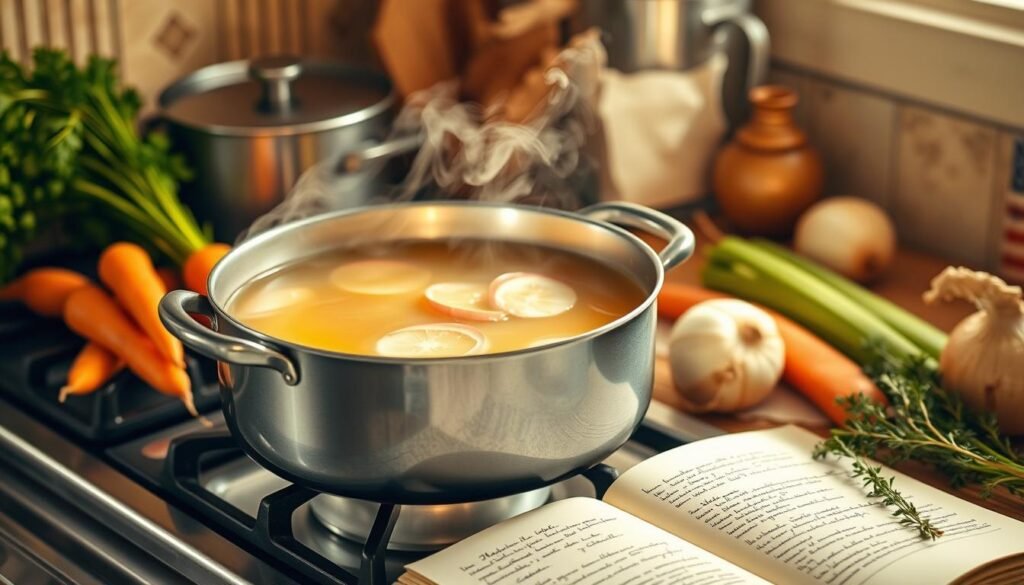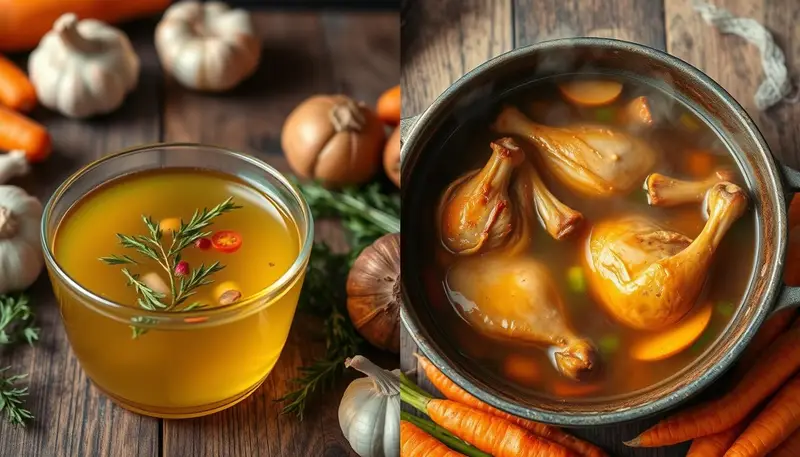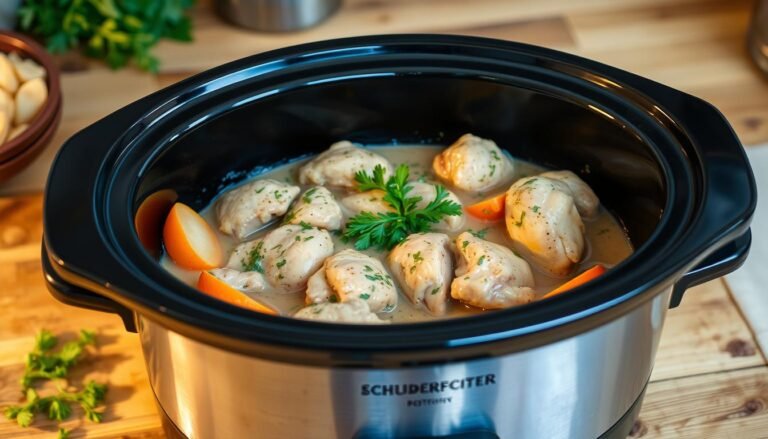Chicken Broth Recipes: Difference Between Broth and Stock
I love cooking at home and have always wondered about chicken broth and stock. These two liquids seem similar but are actually different in many ways. We’ll explore the main differences to help you use them better in your cooking.
Table of Contents
Understanding the Basic Differences
Chicken broth and chicken stock have key differences. These include their ingredients, texture, consistency, color, and appearance. These differences affect how they are used in cooking.
Key Components and Ingredients
Chicken stock is made by simmering chicken bones for 4 to 6 hours. It also includes a mirepoix (carrots, celery, onions) and herbs. This long simmer extracts collagen, making the stock thick and gelatinous when chilled.
Chicken broth, however, is made in 45 to 120 minutes. It uses chicken meat, vegetables, and seasonings. This shorter time makes the broth thinner and more flavorful.
Texture and Consistency Variations
Chicken stock’s long simmer releases more gelatin. This makes it rich and velvety. Chicken broth, with its shorter cooking time, is lighter and thinner.
This texture difference affects how they’re used. Stock is great for sauces and gravies. Broth is better for soups and stews where a lighter liquid is needed.
Color and Appearance Distinctions
Chicken stock is darker and more opaque than broth. This is because the bones release more nutrients during the longer simmer. This results in a more complex flavor in the stock.
Knowing the differences between chicken broth and stock is key. It ensures your dishes turn out right, whether it’s a rich sauce or a light soup.
What Makes Chicken Stock Special
Chicken stock is a secret ingredient in cooking. It’s special because of its high collagen content. This comes from simmering bones and cartilage for a long time. This makes the stock gelatinous, adding depth and richness to dishes.
Chicken stock also has a unique flavor. The long cooking time lets bones, veggies, and herbs release their umami. This makes the stock savory and soothing. It’s perfect for soups, stews, and sauces.
Chicken stock is not just tasty. It’s also full of nutrients like protein, minerals, and gelatin. These help with gut health, joint function, and the immune system. Drinking homemade chicken stock can be very nourishing and comforting.
Whether you’re a pro in the kitchen or just starting, chicken stock is essential. It changes the game by adding flavor and texture to your dishes.
| Chicken Stock Benefits | Nutritional Profile |
|---|---|
|
|
“Homemade chicken stock is like liquid gold in the kitchen – it’s the secret ingredient that takes soups, sauces, and stews to the next level.”
Chicken stock is special because it makes any dish better. It combines collagen, flavor, and nutrients. It’s a must-have for every home cook.
The Unique Properties of Chicken Broth
Chicken broth is a kitchen staple known for its savory flavor. It’s used in many dishes, from soups and stews to sauces and gravies. It’s also very nutritious, making it great for any meal.
Flavor Profile and Seasoning
The flavor of chicken broth comes from its seasoning. Unlike chicken stock, it’s made with bones, water, and spices. This gives it a rich, savory taste that enhances dishes.
The chicken broth flavors are perfect for recipes that need a distinct poultry taste.
Common Uses in Cooking
Chicken broth is versatile and can be enjoyed on its own or in many dishes. It’s great for cooking grains, legumes, and for adding flavor to sauces and soups. Its ability to absorb seasonings makes it essential in the kitchen.
Nutritional Benefits
Chicken broth is not just tasty but also very nutritious. It’s full of hydration, electrolytes, and protein. Homemade chicken broth also boosts the immune system with amino acids like arginine and glutamine.
Adding chicken broth to your diet can improve your health and well-being.
“Chicken broth is the foundation of so many comforting and nourishing dishes. Its versatility and health benefits make it a kitchen staple that every home cook should have on hand.”
Making Homemade Chicken Stock
Make your cooking better with homemade chicken stock. It’s easy to make and tastes amazing. Use it in soups, stews, and sauces.
To make your own homemade chicken stock recipe, start by roasting the chicken bones. Then, put the bones in a big pot with onions, carrots, celery, thyme, parsley, and bay leaves. Let it simmer for 4-6 hours, removing any scum that forms.
The long simmering time is key. It pulls out all the good stuff from the bones, making the stock rich and smooth. After it’s done, strain it and let it cool. Then, put it in airtight containers to keep it fresh.
| Ingredient | Quantity |
|---|---|
| Chicken bones | 2 1/2 lbs (from 2 chickens) |
| Onions, chopped | 2 large |
| Carrots, chopped | 3 medium |
| Celery, chopped | 3 stalks |
| Fresh thyme | 4 sprigs |
| Fresh parsley | 1 bunch |
| Bay leaves | 3 |
| Water | 16 cups |
Customize your chicken stock to your liking. Try different herbs and spices to make it your own. It will make your dishes even better.

“Homemade chicken stock is the foundation of so many delicious dishes. The time and care you put into making it really shines through in the final result.”
Essential Chicken Broth Recipes
Chicken broth is a versatile and nourishing ingredient. It can elevate many dishes. Whether it’s a comforting soup or enhancing rice, having a good chicken broth recipe is key. We’ll look at classic homemade methods and quick tips for the perfect homemade broth.
Classic Homemade Broth Method
The base of a great chicken broth is simmering chicken, veggies, and seasonings for a long time. To make a classic homemade broth, you’ll need:
- 1 whole chicken (4-5 lbs), bone-in and skin-on
- 1 onion, roughly chopped
- 2 carrots, peeled and sliced
- 2 celery stalks, sliced
- 4 garlic cloves, peeled
- 5 whole peppercorns
- 4 sprigs of fresh thyme
- 1 bay leaf
- 1/4 teaspoon of fine sea salt
Put all the ingredients in a big pot and cover with water. Bring it to a boil, then lower the heat and simmer for 3 hours. Strain the broth through a fine-mesh sieve, discarding the solids. Let it cool before refrigerating or freezing.
Storage and Preservation Tips
Storing your homemade broth right is crucial for its freshness and taste. Refrigerate the cooled broth in an airtight container for up to 4 days. For longer storage, freeze it in 1-cup portions for up to 3 months. Thaw frozen broth in the fridge or at room temperature when you’re ready to use it.
Time-Saving Techniques
For a quicker chicken broth recipe, try using a pressure cooker or slow cooker. A pressure cooker cuts simmering time to 1 hour. A slow cooker makes a rich broth in 8-10 hours. Play with herbs and spices to create unique flavors.
Cooking Applications and Uses
Chicken stock and broth are great for many dishes. They can make sauces, gravies, and soups taste better. These liquids can take your cooking to the next level.
Stock is perfect for making risottos, stewing meats, and creating sauces. It’s thick and helps thicken dishes. This makes it very useful in the kitchen.
Broth is better for lighter soups and cooking grains. It adds moisture and flavor to recipes. You can use it instead of stock to change the taste of your dishes.
| Cooking Application | Chicken Stock | Chicken Broth |
|---|---|---|
| Sauces and Gravies | Ideal for thickening and binding | Can be used as a flavorful liquid |
| Soups | Adds richness and depth to hearty soups | Works well in lighter, more delicate soups |
| Grains and Risottos | Imparts a deeper, more intense flavor | Provides a flavorful cooking liquid |
| Deglazing Pans | Effectively captures browned bits and adds flavor | Can be used, but may not provide as much richness |
You can use chicken stock and broth in many recipes. Choose the one that fits your taste and dish needs. Try different uses to make your cooking even better.
Storage and Shelf Life Guidelines
Storing your homemade or store-bought chicken broth right is key. It keeps it fresh and safe to eat. Knowing how to store it in the fridge, freezer, and spotting spoilage is important.
Refrigeration Methods
Refrigerating your homemade chicken broth is easy. Use airtight containers for up to 4 days. Store-bought broth stays good in the fridge for 3-4 days after opening. Keeping it sealed tight stops bacteria and keeps the taste fresh.
Freezing Techniques
Freezing extends your chicken broth’s life. Make sure containers have room for expansion when frozen. Homemade broth can last 3 months, and store-bought up to 4 months in the freezer. Freezing in ice cube trays is handy, then bag or container them up.
Signs of Spoilage
Watch for signs your broth has spoiled. Look for bad smells, a cloudy look, or mold. Always date your containers to use the oldest first. If unsure, throw it out to avoid getting sick.
By following these tips, your chicken broth stays fresh and safe. Whether homemade or store-bought, right storage lets you enjoy it for months in your cooking.
| Storage Method | Homemade Chicken Broth | Store-bought Chicken Broth |
|---|---|---|
| Refrigerator | Up to 4 days | Up to 4 days (once opened) |
| Freezer | Up to 3 months | Up to 4 months |
“Properly stored and frozen chicken broth can inspire new recipes and boost the flavor of everyday dishes.”
Professional Tips and Tricks
As a professional chef, I’ve picked up some key tips. Always start with cold water for your broth or stock. This method helps pull out more flavor from your ingredients. Also, avoid letting the liquid boil too hard, as it can make the broth cloudy.
To boost flavor, roast the bones and veggies before simmering them. This step caramelizes the natural sugars, adding a richer taste. Remember to add herbs, spices, and veggies like bay leaves and peppercorns. They’re crucial for a great flavor.
Play with the bone-to-water ratio to get the right consistency. A good rule is 2 pounds of bones for every 1 gallon of water. If you’re tight on space, make a concentrated stock. You can then dilute it as needed.
“The secret to truly flavorful chicken broth or stock lies in the small details. From using cold water to experimenting with roasting, these chef techniques can make all the difference.”
By using these flavor enhancement tips, you’ll make the best chicken broth and stock. Enjoy trying new things and let your creativity in the kitchen shine!

Conclusion
Knowing the difference between chicken broth and chicken stock makes you a better cook. Chicken stock is great for thick, hearty dishes because of its gelatin. Chicken broth, on the other hand, is lighter and seasoned, perfect for many recipes.
Learning to make these culinary basics at home lets you control the flavors. Whether you’re using stock or broth, they’re key to making your food taste amazing. They’re essential for both home cooks and chefs.
Using chicken stock and broth in your cooking opens up new possibilities. By understanding their differences, you can create more delicious dishes. Let your creativity flourish with these kitchen staples.
FAQ
What are the key differences between chicken broth and chicken stock?
What is the difference in the cooking process and ingredients used for chicken stock and chicken broth?
What makes chicken stock unique?
How is chicken broth characterized and what are its common uses?
What are the key steps in making homemade chicken stock?
How do you make classic homemade chicken broth?
When should you use chicken stock vs. chicken broth in your cooking?
How should you store and preserve homemade chicken stock and broth?
What are some professional tips for making better chicken stock and broth?
Leave a Comment & Rate this Recipe!
If you love this recipe, please consider giving it a star rating when you leave a comment. Star ratings help people discover my recipes online. Your support means a lot to me, I appreciate you.
There are no reviews yet. Be the first one to write one.







